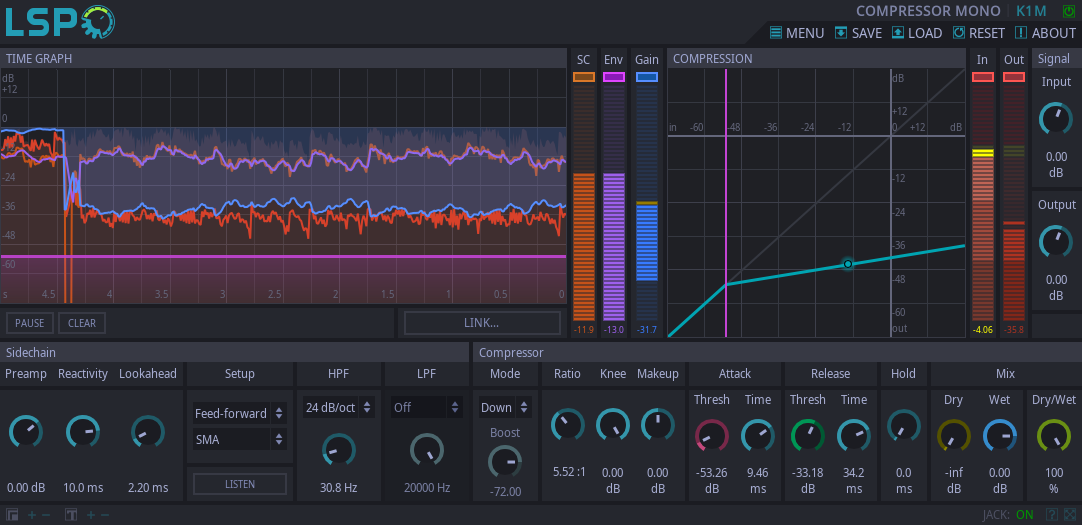Compressor Mono

Detailed: LSP Compressor Mono (K1M)
Formats: CLAP, JACK, LADSPA, LV2, VST2, VST3
Categories: Compressor
Developer: Vladimir Sadovnikov
Description:
This plugin performs compression of mono input signal. Flexible sidechain-control configuration is provided. Different types of compression are possible: downward, upward and parallel. Also compressor may work as limiter in Peak mode with high Ratio and low Attack time.
The compressor can provide two release times. If the compressor's envelope indicated by the dot on the compression curve is above the ‘Release Thresh’ then the ‘Release Time’ parameter is taken as a release time for processing. Otherwise, if the envelope is below the ‘Release Thresh’ then the ‘Attack Time’ parameter is taken as a release time for processing.
Controls:
- Bypass - bypass switch, when turned on (led indicator is shining), the plugin bypasses signal.
- Pause - pauses any updates of the compressor graph.
- Clear - clears all graphs.
- Gain - enables drawing of gain amplification line and corresponding amplification meter.
- SC - enables drawing of sidechain input graph and corresponding level meter.
- Env - enables drawing of compressor's envelope graph and corresponding level meter.
- In - enables drawing of compressor's input signal graph and corresponding level meter.
- Out - enables drawing of compressor's output signal graph and corresponding level meter.
- Link - the name of the shared memory link to pass sidechain signal.
'Sidechain' section:
- Position - the position of the sidechain input. Available variants:
- Feed-forward - sidechain input is connected to compressor's input. More aggressive compression.
- Feed-back - sidechain input is connected to compressor's output. Vintage-style more accurate compression.
- Link - sidechain input is passed by shared memory link.
- Listen - allows to listen the processed sidechain signal.
- Preamp - pre-amplification of the sidechain signal.
- Reactivity - reactivity of the sidechain signal.
- Lookahead - look-ahead time of the sidechain relative to the input signal.
- Type - combo box that allows to switch different types for sidechain processing. Available types are:
- Peak - peak mode.
- RMS - Root Mean Square (RMS) of the input signal.
- LPF - input signal processed by recursive 1-pole Low-Pass Filter (LPF).
- SMA - input signal processed by Simple Moving Average (SMA) filter.
- LPF - allows to set up slope and cut-off frequency for the low-pass filter applied to sidechain signal.
- HPF - allows to set up slope and cut-off frequency for the high-pass filter applied to sidechain signal.
'Compressor' section:
- Mode - compression mode
- Downward (Down) - the downward compressor.
- Upward (Up) - the upward compressor.
- Boosting (Boost) - the boosting compressor (upward with precise boost control).
- Ratio - compression ratio.
- Knee - size of compression knee.
- Makeup - additional amplification gain after compression stage.
- Boost - this knob is related to upward and boosting compression modes only. For upward mode it defines the threshold below which the constant amplification will be applied to the input signal. This prevents compressor from applying infinite amplification to very quiet signals. For boosting mode it defines the overall boost of the signal. The boost threshold is computed automatically.
- Attack Thresh - threshold of the compressor, placed in the middle of the knee.
- Attack Time - attack time of the compressor.
- Release Thresh - relative to the Attack Thresh threshold that sets up the threshold of Release Time. If the current compressor's envelope value is below the configured Release Threshold, the release time is being considered to be the same to the attack time.
- Release Time - release time of the compressor.
- Hold - the time period the envelope holds it's maximum value before starting the release.
- Mix Dry - the amount of dry (unprocessed) signal, useful for parallel compression.
- Mix Wet - the amount of wet (processed) signal, useful for parallel compression.
- Mix Dry/Wet - the knob that controls this balance between mixed dry and wet signal (see Mix Dry and Mix Wet) and the dry (unprocessed) signal.
'Signal' section:
- Input - overall input gain.
- Output - overall output gain.































